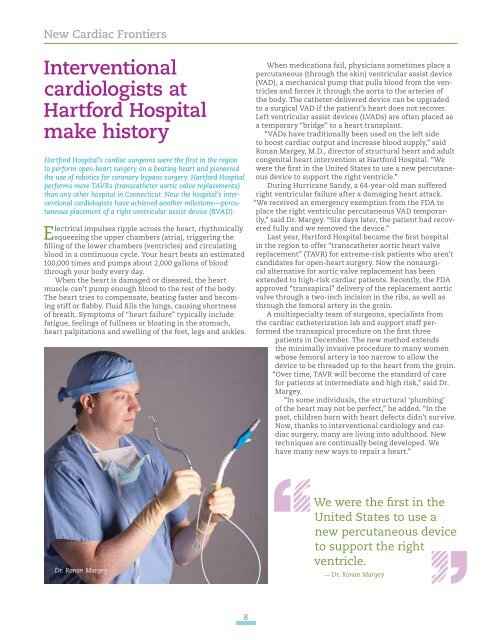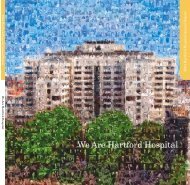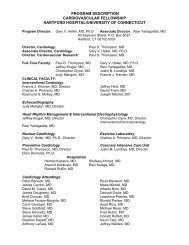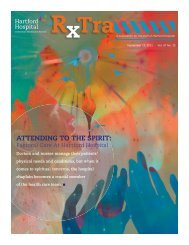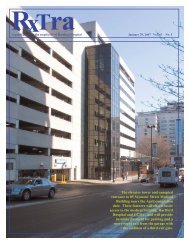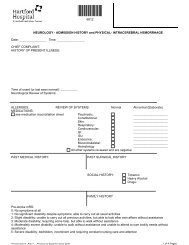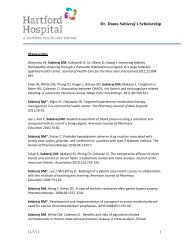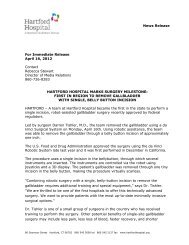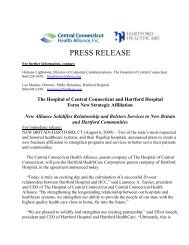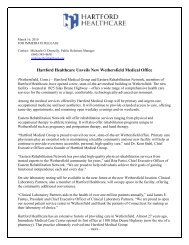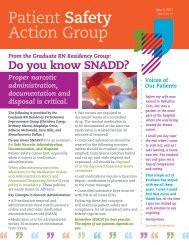Spring, 2013 - Hartford Hospital!
Spring, 2013 - Hartford Hospital!
Spring, 2013 - Hartford Hospital!
Create successful ePaper yourself
Turn your PDF publications into a flip-book with our unique Google optimized e-Paper software.
New Cardiac Frontiers<br />
Interventional<br />
cardiologists at<br />
<strong>Hartford</strong> <strong>Hospital</strong><br />
make history<br />
<strong>Hartford</strong> <strong>Hospital</strong>’s cardiac surgeons were the first in the region<br />
to perform open-heart surgery on a beating heart and pioneered<br />
the use of robotics for coronary bypass surgery. <strong>Hartford</strong> <strong>Hospital</strong><br />
performs more TAVRs (transcatheter aortic valve replacements)<br />
than any other hospital in Connecticut. Now the hospital’s interventional<br />
cardiologists have achieved another milestone—percutaneous<br />
placement of a right ventricular assist device (RVAD).<br />
Electrical impulses ripple across the heart, rhythmically<br />
squeezing the upper chambers (atria), triggering the<br />
filling of the lower chambers (ventricles) and circulating<br />
blood in a continuous cycle. Your heart beats an estimated<br />
100,000 times and pumps about 2,000 gallons of blood<br />
through your body every day.<br />
When the heart is damaged or diseased, the heart<br />
muscle can’t pump enough blood to the rest of the body.<br />
The heart tries to compensate, beating faster and becoming<br />
stiff or flabby. Fluid fills the lungs, causing shortness<br />
of breath. Symptoms of “heart failure” typically include<br />
fatigue, feelings of fullness or bloating in the stomach,<br />
heart palpitations and swelling of the feet, legs and ankles.<br />
When medications fail, physicians sometimes place a<br />
percutaneous (through the skin) ventricular assist device<br />
(VAD), a mechanical pump that pulls blood from the ventricles<br />
and forces it through the aorta to the arteries of<br />
the body. The catheter-delivered device can be upgraded<br />
to a surgical VAD if the patient’s heart does not recover.<br />
Left ventricular assist devices (LVADs) are often placed as<br />
a temporary “bridge” to a heart transplant.<br />
“VADs have traditionally been used on the left side<br />
to boost cardiac output and increase blood supply,” said<br />
Ronan Margey, M.D., director of structural heart and adult<br />
congenital heart intervention at <strong>Hartford</strong> <strong>Hospital</strong>. “We<br />
were the first in the United States to use a new percutaneous<br />
device to support the right ventricle.”<br />
During Hurricane Sandy, a 64-year-old man suffered<br />
right ventricular failure after a damaging heart attack.<br />
“We received an emergency exemption from the FDA to<br />
place the right ventricular percutaneous VAD temporarily,”<br />
said Dr. Margey. “Six days later, the patient had recovered<br />
fully and we removed the device.”<br />
Last year, <strong>Hartford</strong> <strong>Hospital</strong> became the first hospital<br />
in the region to offer “transcatheter aortic heart valve<br />
replacement” (TAVR) for extreme-risk patients who aren’t<br />
candidates for open-heart surgery. Now the nonsurgical<br />
alternative for aortic valve replacement has been<br />
extended to high-risk cardiac patients. Recently, the FDA<br />
approved “transapical” delivery of the replacement aortic<br />
valve through a two-inch incision in the ribs, as well as<br />
through the femoral artery in the groin.<br />
A multispecialty team of surgeons, specialists from<br />
the cardiac catheterization lab and support staff performed<br />
the transapical procedure on the first three<br />
patients in December. The new method extends<br />
the minimally invasive procedure to many women<br />
whose femoral artery is too narrow to allow the<br />
device to be threaded up to the heart from the groin.<br />
“Over time, TAVR will become the standard of care<br />
for patients at intermediate and high risk,” said Dr.<br />
Margey.<br />
“In some individuals, the structural ‘plumbing’<br />
of the heart may not be perfect,” he added. “In the<br />
past, children born with heart defects didn’t survive.<br />
Now, thanks to interventional cardiology and cardiac<br />
surgery, many are living into adulthood. New<br />
techniques are continually being developed. We<br />
have many new ways to repair a heart.”<br />
Dr. Ronan Margey<br />
We were the first in the<br />
United States to use a<br />
new percutaneous device<br />
to support the right<br />
ventricle.<br />
— Dr. Ronan Margey<br />
8


